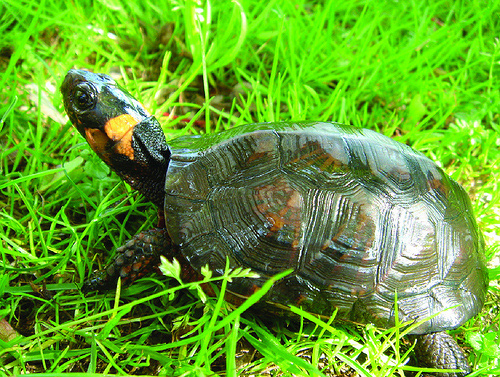The bog turtle is a very small turtle. It is the smallest turtle in New England. Its shell, or carapace, is moderately domed and oblong. The scales, or scutes, on the carapace are very sculptured but are worn smooth as the turtle ages. The scutes may also have a light brown or orangish "sunburst" pattern. The turtle is a brown color overall with a bright orange spot on each side of its head. The carapace of bog turtles measure 3 1/2 to 4 inches long.
Bog turtles range from eastern New York, Massachusettes and adjacent Connecticut south through New Jersey and parts of Pennsylvania, Delaware and Maryland. There are some in the Finger Lakes region of New York and in bits of Virginia and North Carolina. In Connecticut bog turtles are only found where there is calcium or limestone bedrock. Such areas are located in the valleys of western Connecticut between the Housatonic River and the New York border. The bog turtle's population is in decline in Connecticut, largely because the wetlands and marshes it requires for habitat have been developed and fragmented. Bog turtles are an Endangered species in Connecticut and within ten years or so could become the first reptile to become extinct in Connecticut.
Bog turtles reside in wetlands with an open canopy. They need sunlit marshy meadows, wet pastures, and bogs. They like narrow, shallow slow-moving rivulets.
In New England bog turtles breed in late May or June. In June or July females lay 2 to 5 elliptical eggs with leathery shells. The nest site is often in a shrubby tussock or out in the open on spaghnum moss. The eggs hatch in late August or early September. These turtles reach sexual maturity in 5 to 7 years and can live 40 years or more.
From about mid October to April New England bog turtles hibernate. They may use tunnels in the wetland tussocks. Turtles cannot regulate their body temperature internally so on spring days bog turtles may be basking in the sun to warm themselves on the tussocks into which they tunnel for hibernation. On very hot days they often bury themselves in mud or under vegetation with just a small part of their shell showing. Bog turtles have been known to aestivate in very hot summers. Aestivation is a dormant state entered to deal with hot weather.
The diet of bog turtles includes tadpoles, slugs, snails, worms and insects.
Bog turtles aren't often seen as they are very small and have secretive habits.
